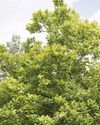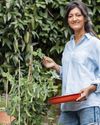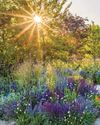
We're in the middle of the summer pruning season. Neatening up early-summer shrubs and plants once they have finished flowering is a good task to do now so that the garden is ready for its late-summer show. It's also time to cut back trained fruit trees to help restrict growth for the next season. Drupes (stone fruits) such as Prunus, which should be trimmed now to prevent disease, can also be tackled, but be aware that you may lose some fruit.
It can also be a good time to begin working on hedges. Though old wisdom would advise pruning evergreens such as Buxus and Ligustrum in May, I like the woolly effect of the fresh spring growth if it's left a little longer. But all hedges, including box, privet and conifers like yew and cypress, can be cut back anytime between now and mid-autumn, as long as there are no nesting birds. Trimming shrubs, such as repeat-flowering roses, now may encourage a second flush of flowers during the later part of the season.
Deciduous magnolias
Magnolias that lose their leaves in winter only need pruning to keep them healthy and in shape, and mid-summer to autumn is the time to do it. Take out dead, damaged or diseased branches, as well as any that are rubbing against each other. If reshaping or reducing size, spread the cuts over a few years to reduce stressing the tree. Cut back to a natural fork.
Other plants to prune now
Summer pruning can extend the flowering season of many shrubs. Trimming off leafy growth now reduces unwanted vigour and can promote next year's flowering and fruit production.
WISTERIA This needs two prunes a year - one in late winter and one in mid-summer. Cut back long shoots to around seven buds.
Esta historia es de la edición July 2024 de BBC Gardeners World.
Comience su prueba gratuita de Magzter GOLD de 7 días para acceder a miles de historias premium seleccionadas y a más de 9,000 revistas y periódicos.
Ya eres suscriptor ? Conectar
Esta historia es de la edición July 2024 de BBC Gardeners World.
Comience su prueba gratuita de Magzter GOLD de 7 días para acceder a miles de historias premium seleccionadas y a más de 9,000 revistas y periódicos.
Ya eres suscriptor? Conectar

A new plot for tasty crops
Taking on a new allotment needn't be hard work. By simply following a few easy tips you can have bumper crops in no time, just like Alessandro Vitale

We love July
July is an island floating between the joy of June and the slightly fatigued month of August. It's a grown-up month: the year has shrugged off its adolescent exuberances, the weather is (hopefully) warm enough for ice cream to be one of your five a day, the sea should be swimmable without (too much) danger of hypothermia and thoughts will be of holiday shenanigans and family barbecues. School's out this month, the next tranche of glorious summer colour is washing across our borders and it's my birthday. Lots of reasons to give three rousing cheers for July!

YOUR PRUNING MONTH
Now, at the height of summer, Frances Tophill shows how to boost your plants' health and productivity with a timely cut

Hassle-free harvests
Flowers are out in abundance this month and for Jack Wallington, many of these blooms make delicious, low-effort pickings

Bite-sized bounties
Glorious doorstep harvests can easily turn into gluts, so let Rukmini Iyer's recipes help you savour every last bit

Upcycled outdoor living
Create unique and stylish garden features for minimal cost using reclaimed materials and simple DIY skills. Helen Riches shares four step-by-step projects and more inspiring eco tips

Secrets of a COLOURFUL GARDEN
Buildings and landscapes can play a vital role in supercharging your space, as Nick Bailey demonstrates

Greening up a city balcony
Looking for sustainable, small-space gardening ideas? Take inspiration from Oliver Hymans' transformed balcony garden in north-east London - now a lush, green haven for humans and wildlife

The dry and mighty garden
As we adapt our gardens to a more volatile climate, Alan Titchmarsh reveals how to create a drought-tolerant plot and picks his top plant performers

Nature knows best
Carol Klein explains how to choose plants for specific growing conditions, based on what has naturally adapted to thrive there